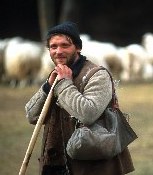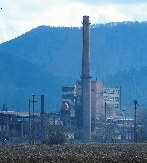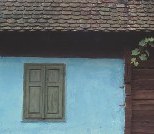 | Photo:
Karin Steinbrueck |
Land of Plenty
Tony Snape
The Carpathian mountains, which stretch southwards across seven countries and over 200,000 km2, from the Danube in Austria to the Iron Gate Dam in Romania, are home to 16 million people, most of whom live in rural communities. The region is also the last refuge in Europe for thousands of bears, wolves and lynx.
People and predatory animals have been living side-by-side in the Carpathians for millennia. Farmers using traditional methods have developed protection systems that lead to a harmonious coexistence: shepherds sleeping with their flocks at night; deer and boar populations are maintained in the forests as prey; inhabited villages marking the limits of the carnivores' roaming.
Indeed, the biggest threat to the Carpathian people's traditional life, and to the survival of wildlife, is not predatory beast, but predatory man. Privatisation of forests since the collapse of Communism is leading to overlogging. Deforestation, due to climate change, is also occurring, threatening wildlife habitat. In some areas, poaching is out of control and the traditional nature protection methods practiced by livestock breeders are under pressure from the difficult economic situation faced by most Central and Eastern European (CEE) countries.
In addition, five of the Carpathian countries will join the European Union over the next few years. The prospect of EU accession will see new economic development in the region. Roads, factories and hotels could ruin the Carpathians unless a comprehensive system of habitat protection is established. New nature conservation standards are needed in the eastern Carpathian countries—the Czech Republic, Hungary, Poland, Romania, Slovakia and Ukraine—if wildlife and traditional communities are to be preserved.
Living from the land
Mountain shepherding has been one of the strongest elements of Carpathian culture, though under Communism the number of sheep fell by two-thirds. Now conservation organisations are helping revive sheep farming in the mountains; sheep help keep the territorial equilibrium between man, carnivore and grazed land, conserving endemic plant species such as orchids.
 | | Photo: David McCairley | Nicolae Coroiu has 500 sheep in a valley at Piatra Craiului, in the Romanian Carpathians. He sells milk, cheese, wool and lambs from the flock. "The winters are very hard here. I graze my sheep in a neighbouring valley, because the one I live in is too open and doesn't give enough protection against the winter weather," says Nicolae, who, like many Carpathians, shepherds on horseback. With his horse and flock, he covers thousands of kilometres a year roaming the mountains in search of good, sheltered grazing.
Ovidiu Ionesco, coordinator of the Carpathian Large Carnivore Project, says there are around 8000 bears living in the mountains, 4000 wolves and 2500 lynx. His project, which is supported by the World Wildlife Fund (WWF), covers an area of 2000 km2 around Braşov and aims to educate people in the villages about large carnivores and promote economic activity that is compatible with conserving the carnivores' natural habitat.
"Here eco-tourism is beginning to play a key role. Although visitors to the project are unlikely to see any wolves in the wild themselves, they are often just delighted to see their tracks. The same goes for lynx. Bears are easier to spot and more numerous, so visitors do have a realistic chance of spotting them," says Ovidiu.
The project has advised some 200 guesthouses on setting up in Piatra Craiului and provides some of them with clientele. Last year, 120 proprietors went to France to see how the chambre d'hôte system works and have adopted many good French practices in Romania, including the value of certification and inspection in order to maintain standards. Later this year, the Romanians play host to their French counterparts in a return visit.
In the Romanian Carpathians, eco-tourism is increasing year-on-year, with an influx of visitors from Western European countries in search of good climbing, walking, horse-riding and cross-country skiing territory. Gheorghita Moroie, a tourist guide and guesthouse owner in Magura, used to work at a munitions factory in the nearby town of Zanesti.
 | | Photo: David McCairley | "I spent 30 years testing explosives," he said. "Demand for the munitions fell off after Communism. There was no point hanging around an empty factory, so we decided to go into the guesthouse business. We organise our activities towards eco-tourists and get parties of French and Italian youngsters, for instance. Our future is in the mountains now. It is possible for us to make a good living here. And, of course, it is a much healthier environment."
A new beginning for rural communities
In the White Carpathians, across the Czech and Slovak border, the region is undertaking a fascinating experiment with organic farming and energy-efficient heating systems. There are some 39 organic farms in Bílé Karpaty on the Czech side of the border. The people here farm cattle and sheep, grow cereals, herbs and spices and produce plum brandy and organic cider.
Bohumil Husářík, a bio-farmer in the area, said the organic initiative came mainly because farmers couldn't afford the pesticides and fertilisers used by larger concerns. "It means we turn to traditional methods of farming, too," he says, "those used by my parents and grandparents. Our produce is no more highly priced than chemical products and people in this region are definitely interested in organic. I cannot supply all the demand." Bohumil is a member of an association of bio-farmers, which certifies their produce as chemical-free.
Another certificate awarded in the Czech region is: "Traditions of the White Carpathians." This approval is used for fruit juice, tea, dried fruit and will soon extend to local crafts.
Several farms in and around the village of Hostětín already have the certificate. One is an apple juice production plant. The area has an astonishing 250 naturally occurring fruit varieties. In planting new orchards, cultivators have found that researching the history of tree culture in the Carpathians leads to the right solutions.
"We have found varieties of cherries, plums, apples, pears and nuts that had disappeared from the official lists under Communism," said orchard manager Rostislav Trávníček. "Our tree-mapping process is truly a voyage of discovery."
 | | Photo: Karin Steinbrueck | Hostětín is a typical Carpathian village, with 230 inhabitants and about 80 houses. People there live mainly off the land. But Hostětín is rather special, too, for there is a new prosperity developing, based on organic farming methods and also energy conservation. The village is proving a model for the rest of the Carpathian region, with visitors from as far away as Romania arriving to learn from the success of its micro-projects.
Until recently, like many across the region, Hostětín villagers burned brown coal. However, a joint Czech and Dutch government project, which installed a biomass district heating system, has cut down radically on CO-2 emissions and saves the villagers around 600MWh per year in electricity costs.
The village buys wood chips leftover from local sawmills and burns them in a hi-tech boiler, from which hot water is circulated to 80 percent of the houses. The ash from the boiler is used as fertiliser in the fields, free of heavy metal.
Other energy conservation measures are operating in the village, too. Several houses have solar panels fitted to their roofs and the sewage treatment plant uses reedbeds as natural filters instead of electrically powered pumps.
"The reedbed plant offers a great difference from conventional sewage systems. Not only does it save energy, but there is no concrete or piping and it provides a great natural habitat for birds and frogs," explained Hostětín deputy mayor Radim Machů.
The Carpathians as an "ecoregion"
Following the collapse of Communism in CEE, the Carpathian peoples—often very poor—are faced with a new beginning. First, they are in the process of rediscovering their identities and confidence in the post-Communism era. But the economic reality also means that they have to find new sources of income.
The best thing for the Carpathians eco-system is that they find new income sources in the places they want to live, usually their home villages. Migration from the mountains will destroy not only the villages but good forest management practices too, and it will endanger the carnivore populations as well as other endemic species such as orchids and rare fruit trees.
This is why the WWF and other organisations have come together on the Carpathian Ecoregion Initiative to protect the region from unfettered economic development and help its peoples reach prosperity through sustainable means. Pressure to develop the mountain regions will increase, as Carpathian countries join the European Union.
The Carpathian ecoregion is one of 200 in the world where the WWF is focusing its efforts to preserve outstanding biodiversity. Through a dynamic partnership of some 50 key decision-making organisations from within and outside the region (government agencies, scientific institutions and NGOs), the Carpathians has begun a sustainable development plan that will run for 50 years, conserving the region as one of the world's most prized wildlife areas and a means to prosperity for its inhabitants.
In some villages, there is still no electricity. In others there are neither telephones nor gas supplies. Many have no vehicles, just carts and horses. But one thing these people do have, which makes them unique, is a stunning homeland, rich in natural wealth. If properly managed, the Carpathian peoples have a resource that will last them forever, and provide a quality of life equal to, if not better than, any other on the planet.
As one Romanian villager, Ene Dobre, said: "I was born here and I want to live here. No matter how hard life in the village is, it is still my village."
Tony Snape, 23 April 2001
Tony Snape is a journalist writing on environmental and EU issues.
Moving on:
|








